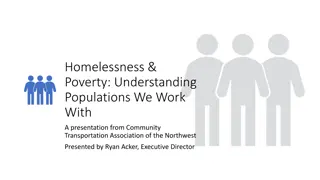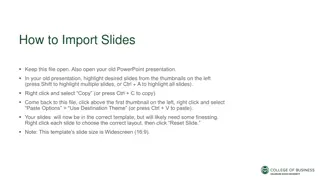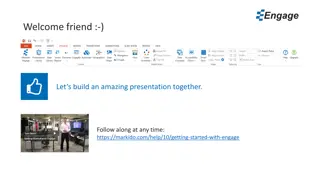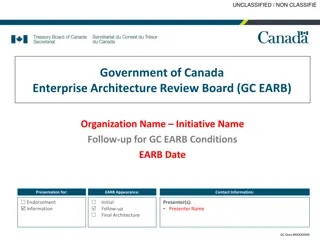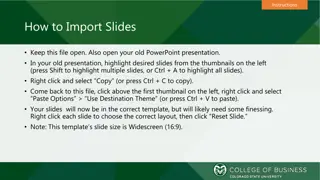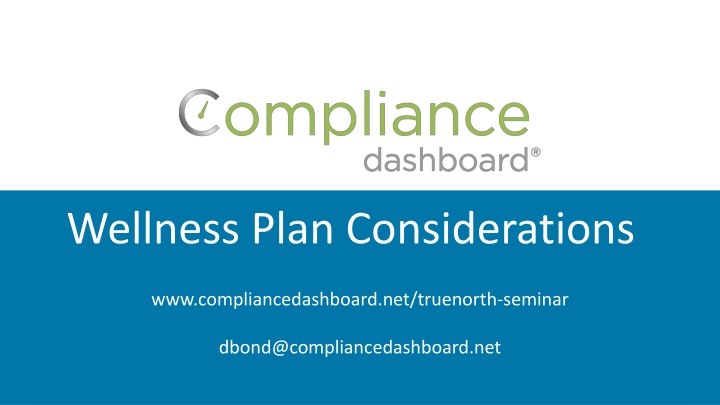
Understanding Wellness Programs and Considerations
Explore the importance and complexities of wellness programs, including their benefits, legal implications, risks, and compliance considerations. Discover why wellness programs are essential, but their rules can be challenging to navigate. Learn about the involvement of third-party vendors, group health plan ties, compliance requirements, and other key considerations in implementing effective wellness initiatives.
Download Presentation

Please find below an Image/Link to download the presentation.
The content on the website is provided AS IS for your information and personal use only. It may not be sold, licensed, or shared on other websites without obtaining consent from the author. If you encounter any issues during the download, it is possible that the publisher has removed the file from their server.
You are allowed to download the files provided on this website for personal or commercial use, subject to the condition that they are used lawfully. All files are the property of their respective owners.
The content on the website is provided AS IS for your information and personal use only. It may not be sold, licensed, or shared on other websites without obtaining consent from the author.
E N D
Presentation Transcript
Wellness Plan Considerations www.compliancedashboard.net/truenorth-seminar dbond@compliancedashboard.net
Why Wellness? SHRM 2017 Employee Benefits 71% Have a Wellness Benefit 59% Have A General Wellness Program 24% Increased Wellness Benefits (Highest)
Why Wellness? Everyone Loves Them No One Understands the Rules! Federal Agencies Federal Courts Employers
Wellness Programs AARP v. EEOC EEOC s incentive level Not Well-Reasoned What makes 30% incentive voluntary? Remanded back to EEOC for consideration Still the Law of the Land
Wellness Programs What Are The Risks? Excise taxes that must be self-reported on Form 8928 Discrimination lawsuits Tax penalties See Wellness Taxes and Penalties chart
Wellness Programs No Worries! Stand-Alone Information or Activity Only - Voluntary No Medical Tests HRA Doesn t Ask Medical History or Genetic Information No Incentives
Third Party Vendors Third Party Vendors Provide integrated set of services Almost necessity for robust wellness plan Deal with many compliance issues Business Associates for HIPAA Privacy and Security But employer retains responsibility and liability!
Wellness Programs Group Health Plan Tied to the Medical Plan; and/or Medical Benefits Blood Screenings Blood Pressure Height and Weight
Wellness Programs Group Health Plan Compliance ERISA: Reporting and Disclosure COBRA: Continuation ADEA and Title VII: Discrimination FLSA: Overtime ACA: Market Reform Rules HIPAA: Privacy and Security
Wellness Programs Other Considerations Cafeteria Plans: Premium Credit or FSA Contribution Nondiscrimination Testing: FSA Contributions ACA: Affordability, MV and GF Status W-2 Reporting: Cost of Wellness Program IRS: Taxation of Gifts or Prizes
Rabbit Trail On-Site Clinics GHP if provide more than first aid Excepted Benefit, but not from HIPAA Privacy & Security First Dollar Coverage?
HIPAA Nondiscrimination (as Amended by ACA) General Regulation Prohibits charging different premium based on health factor Excepted Benefit Only if stand-alone and not GHP Wellness Exception Can discriminate based on meeting requirements of wellness program
HIPAA Nondiscrimination (as Amended by ACA) Health Contingent Participatory Outcome- Based Activity Only
HIPAA Nondiscrimination (as Amended by ACA) Participatory Incentive solely for participation or no incentive No Incentive Limit (except, see ADA) Can include HRA or diagnostic screening HRA can include questions regarding health status
HIPAA Nondiscrimination (as Amended by ACA) Health-Contingent If must satisfy standard related to health factor for incentive: 1. Earned once a year 2. Combined rewards: 30% of coverage (+20% tobacco) 3. Designed to promote health/prevent disease 4. Available to all similarly situated employees 5. Reasonable alternatives disclosed in plan materials
HIPAA Nondiscrimination (as Amended by ACA) Health-Contingent Program Two Types 1. Activity Only Walking, diet or exercise program without regard to outcome 2. Outcome-Based Test screening then attainment of target outcome or not smoking See Activity-Only vs Outcome-Based chart
HIPAA Nondiscrimination (as Amended by ACA) Reasonable Alternative Standards 1. Activity Only Unreasonably difficult due to medical condition Medically inadvisable 2. Outcome-Based Allowed regardless of whether it was unreasonably difficult due medically inadvisable
Americans with Disabilities Act (ADA) General Regulation Cannot discriminate against an individual with a disability in regard to a fringe benefit Reasonable accommodations for individuals with a disability to have equal access to fringe benefits Cannot make disability related inquiries or require medical examination
Americans with Disabilities Act (ADA) ADA Considerations What is a disability related inquiry under ADA Likely to elicit information about a disability Questions about medical history OK to ask about smoking What is a medical exam under ADA Blood draw or other tests to detect high blood pressure, high cholesterol, or diabetes. Measuring waistline OK
Americans with Disabilities Act (ADA) Voluntary Wellness Program Exception (not in HIPAA) Permits voluntary medical examinations and medical histories But, the Employer Cannot: Require participation Deny access to GHP, or limit coverage Retaliate Make incentive coercive
Americans with Disabilities Act (ADA) Voluntary Wellness Program Exception (not in HIPAA) If GHP and makes disability-related inquiry or medical exam Incentive Limit: 30% of total cost of coverage Includes HIPAA Participatory Programs Actual cost of coverage required to participate Otherwise, lowest cost option Reasonable accommodations to allow participation
Genetic Information Nondiscrimination Act (GINA) Title I Prohibits collecting genetic information for determining eligibility for wellness rewards Impacts HRAs they cannot: Ask about family medical history Request genetic information for enrollment Provide rewards to collect genetic information; Consider two distinct HRAs
Genetic Information Nondiscrimination Act (GINA) Title II Unlawful to request, require, or purchase genetic information of an employee or family member Includes Wellness Exception 2016 GINA Amendments (effective Jan. 1, 2017) Incentive: 30% for spouses medical history Employee incentive available whether or not answers genetic questions Must be reasonably designed
Wellness Regulations (see HIPAA vs ADA chart) Decision Tree for Incentives 1. If disability related inquiry or medical exam Follow ADA incentive restrictions 2. If inquiry/exam includes genetic information Follow ADA and GINA incentive restrictions 3. Otherwise, if GHP Follow HIPAA Nondiscrimination incentive restrictions
Incentives How to Calculate HIPAA Cost of coverage enrolled Employee Only or Family Coverage ADA Cost of Employee Only coverage Self-Insured Plans?
HIPAA vs ADA Smoking Cessation HIPAA Additional 20% ADA No additional incentive OK to ask about tobacco use Testing for tobacco use is a medical exam
Notice Requirements HIPAA Health Contingent Programs Triggered with Health Contingent Program Describe availability for RAS in all plan materials Include contact information Recommendations of physician will be accommodated Sample language available
Notice Requirements ADA Triggered with voluntary HRA or medical examination How that information will be used, shared, and kept confidential On or after 1/1/2017 Provide before collection of information DOL Sample Notice available
Notice Requirements GINA Spousal Notice Triggered when seek genetic information or family medical history from spouse. How genetic information will be obtain, used, and restricted Prior, knowing, written, and voluntary authorization from spouse before completion of HRA
Wellness Programs Court Cases Is wellness protected by ADA safe harbor? Some courts say yes EEOC says NO! AARP v. EEOC Generally, wellness cannot be condition of employment
Helpful Resources RAND Workplace Wellness Study and Report. https://www.dol.gov/sites/default/files/ebsa/researchers/analysis/health-and- welfare/workplacewellnessstudyfinal.pdf Workplace Wellness Programs Services Offered, Participation, and Incentives https://www.dol.gov/sites/default/files/ebsa/researchers/analysis/health-and- welfare/WellnessStudyFinal.pdf Kaiser Family Foundation/Health Research & Educational Trust, 2016 Employer Health Benefits Survey http://www.kff.org/health-costs/report/2016-employer-health-benefits-survey/
Employer Size & Compliance Laws
Employee Counts (See Counting Methods) Employees Regulation 2 ERISA or PHSA 15 Title VII, PDA ADA, GINA, ADEA, COBRA, Medicare 2nd Payer (Age) 20 50 FMLA, ALE under ACA 51 MHPAEA Form 5500, Medicare 2nd Payer (Disability) 100 250 (W-2s) Report Cost of Health Benefits on W-2
Relief From the ACA? Word From the IRS The (Presidents) Executive Order does not change the law; the legislative provisions of the ACA are still in force until changed by the Congress, and taxpayers remain required to follow the law and pay what they may owe. Denise Trujillo Branch Chief, Health and Welfare Branch, Office of Associate Chief Counsel
Transitional Relief Has Come to An End 1. Dropping employer coverage to enroll in exchange 2. Offer of Coverage by the first payroll period 3. No Penalties for ALEs with fewer than 100 FTEs 4. Reduced Penalties for ALEs with greater than 100 FTEs 5. Offer to 70% of FTEs
Measurement and Stability What Are The Risks? Subsection (a) Penalty FTEs (minus 30) X $2,260 (2017) If at least one full-time employee obtains subsidized Exchange coverage
Determining FTEs for Offer of Coverage Unique Counting Methods FTE for ALE Does Not Equal FTE for reporting Must use 130 hours per month as the only basis to identify full-time employees. Four categories of employees Hour of Service Can change counting method each calendar year
Monthly Measurement Method Count Hours for Each Month May use different methods May use successive one-week periods Limited non-assessment period Coordinate with 90 day waiting period See Monthly Measurement chart
Look Back Method Variable-Hour Employees Employer s reasonable expectations New vs. Ongoing Variable Hour vs. Seasonal No Penalties during Initial Measurement Period Limited non-assessment period (coordinate with 90 day) See Monthly Measurement chart
Look Back Method Breaks in Service Break of 13 (26) or more consecutive weeks Rule of Parity Unpaid Leave FMLA - USERRA
Look Back Method Interaction with Other Regulations COBRA Plan Eligibility vs Shared Responsibility Delayed employer notice rule Cafeteria Plans Change in employment status Must have other coverage Requires plan amendment
Counting Methods Documentation No rules for hours tracked, but may be helpful in dispute Consistency with Plan Document See Sample FTE policy
Remember ERISA Section 510 Fiduciary Responsibility Employer should have legitimate business reason in reclassifying employees causing loss of benefits Also Whistleblower Act Cannot retaliate because of premium credit May include possibility of receiving a premium credit
Affordability Regulation Employee s cost of self-only coverage cannot exceed a specified percentage of the employee s household income. 2017: 9.69% 2018: 9.56% Exchange Notice: disclose whether coverage is Affordable
Affordability What Are The Risks? Subsection (b) Penalty $3,390 (2017) Per FTE employee that obtains subsidized Exchange coverage Capped by amount of Subsection (a) Penalty
Affordability Safe Harbors Overview Employers may only use if: Offer FTEs and dependents opportunity to enroll in MEC Coverage provides MV Apply to any reasonable category of employees if consistent Employee can still get premium credit if eligible
Affordability Safe Harbor #1 W-2 Safe Harbor Affordability based on Box 1 of W-2 Taxable wages, bonuses, tips, and other compensation Calculate after end of calendar year W-2 wages can be adjusted to reflect period of coverage
Affordability Safe Harbor #2 Rate of Pay Safe Harbor Prospective, design-based method Hourly Employees Lowest rate as of 1st day of coverage or during any month Can apply regardless of actual hours worked Salaried Employees Rate as of 1st day of coverage not available if pay reduced






